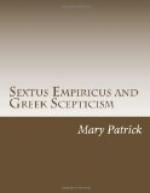[1] Diog. IX. 12, 116.
[2] Zeller Op. cit. III. p. 39.
A part of Sextus’ books also may have been written in Alexandria. [Greek: Pros phusikous] could have been written in Alexandria.[1] If these were also lectures, then Sextus taught in Alexandria as well as elsewhere. The history of Eastern literature for the centuries immediately following the time of Sextus, showing as it does in so many instances the influence of Pyrrhonism, and a knowledge of the Hypotyposes, furnishes us with an incontestable proof that the school could not have been for a long time removed from the East, and the absence of such knowledge in Roman literature is also a strong argument against its long continuance in that city. It would seem, however, from all the data at command, that during the years that the Sceptical School was removed from Alexandria, its head quarters were in Rome, and that the Pyrrhonean Hypotyposes were delivered in Rome. Let us briefly consider the arguments in favour of such a hypothesis. Scepticism was not unknown in Rome. Pappenheim quotes the remark of Cicero that Pyrrhonism was long since dead, and the sarcasm of Seneca, Quis est qui tradat praecepta Pyrrhonis? as an argument against the knowledge of Pyrrhonism in Rome. We must remember, however, that in Cicero’s time Aenesidemus had not yet separated himself from the Academy; or if we consider the Lucius Tubero to whom Aenesidemus dedicated his works, as the same Lucius Tubero who was the friend of Cicero in his youth, and accordingly fix the date of Aenesidemus about 50 B.C.,[2] even then Aenesidemus’ work in Alexandria was too late to have necessarily been known to Cicero, whose remark must have been referred to the old school of Scepticism. Should we grant, however, that the statements of Cicero and Seneca prove that in their time Pyrrhonism was extinct in Rome, they certainly do not show that after their death it could not have again revived, for the Hypotyposes were delivered more than a century after the death of Seneca. There are very few writers in Aenesidemus’ own time who showed any influence of his teachings.[3] This influence was felt later, as Pyrrhonism became better known. That Pyrrhonism received some attention in Rome before the time of Sextus is nevertheless demonstrated by the teachings of Favorinus there. Although Favorinus was known as an Academician, the title of his principal work was [Greek: tous philosophoumenous auto ton logon, hon aristoi hoi Purrhoneioi].[4] Suidas calls Favorinus a great author and learned in all science and philosophy,[5] and Favorinus made Rome the centre of his teaching and writing. His date is fixed by Zeller at 80-150 A.D., therefore Pyrrhonism was known in Rome shortly before the time of Sextus.
[1] Pappenheim Sitz der
Skeptischen Schule; Archiv fuer
Geschichte
der Phil., 1888; Adv. Math. X. 15,
95.
[2] Zeller Op. cit. III. 10.




